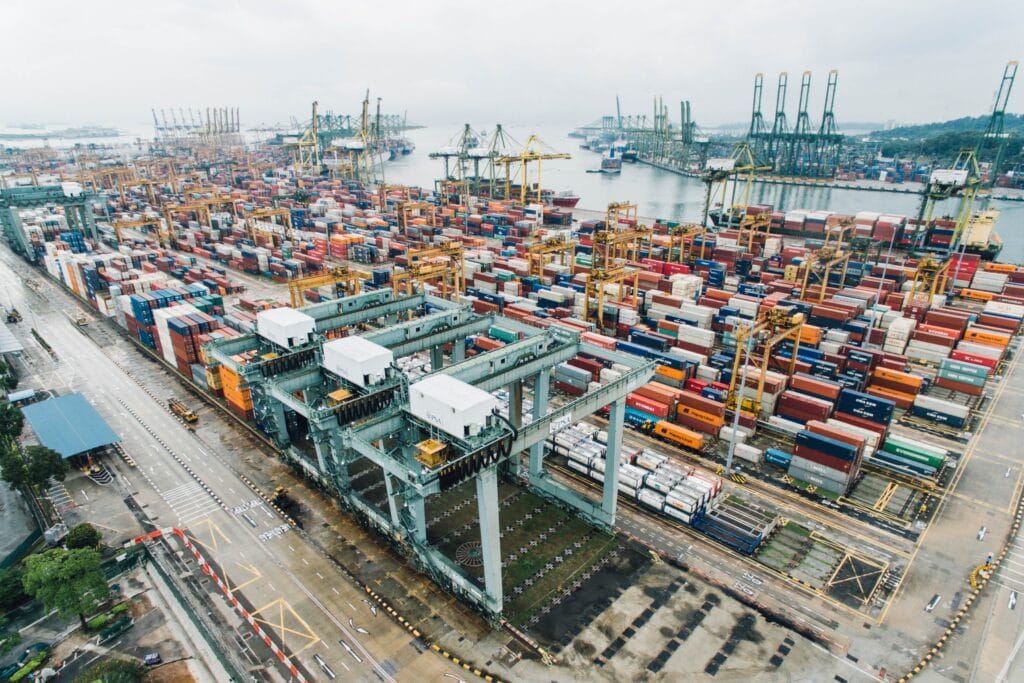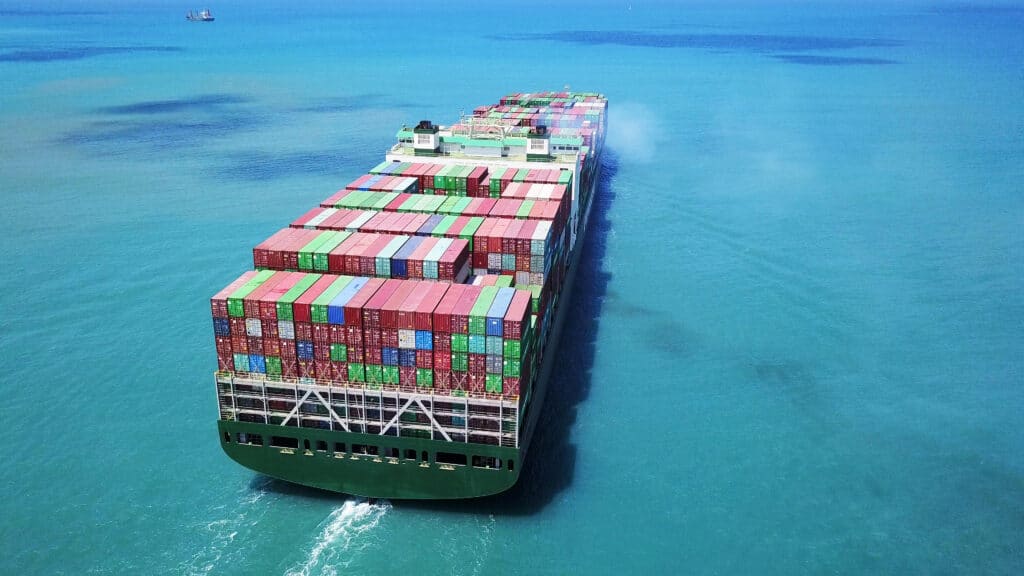Most people never give a thought to the global supply chain–indeed, many people don’t really understand what it is, apart from blaming “supply chain issues” for their late package. In this article, we’re going to take a closer look at the maritime supply chain and how it relates to the supply chain as a whole.
Defining the Maritime Supply Chain and How it Operates
Maritime supply chain refers to the movement of cargo, as well as any related support, involving two destinations and using both maritime (ocean) and land transportation. It’s an entire network of interconnecting systems that involve freight forwarders, shipping lines, port terminal operators, and land-based logistics systems.
Freight forwarders are companies or individuals that organize the shipment of goods, while shipping lines own and operate the vessels that transport the goods across the sea. Port terminal operators own or lease the port space where goods are delivered and then managed by land-based logistics systems to get the goods to their final destination.
All of these are integral points of contact and must be in constant communication to avoid delays or misdirected shipments. Bad weather, oversaturated ports, and crowded shipping routes can throw a wrench into any shipment if not carefully planned, observed, and rerouted if necessary.
This system has been in place on a global scale for hundreds of years and led to exploration all over the world as merchants searched for better routes and various spices and precious materials. However, in today’s world the maritime supply chain has become highly dynamic and complex as it grows to accommodate an ever-growing technology, consumer preferences, and global trade patterns.
There are several points of contact within the maritime supply chain. These include external suppliers, internal departments, external distributors, and consumers. All these pieces must move together in concert, and what’s more, take note of important influences such as customer expectations, technological innovations, globalization, competition, government regulation, and sustainability.
What is the Meaning of ETA, ETD, ATD, & ATA in Shipping ?
Companies and people around the globe rely on precise predictions of when a vessel will arrive with a shipment of goods and services. In shipping, ETA means…
Why is the Maritime Supply Chain So Important?
Sustaining Global Economy
The maritime supply chain is more important than ever in our global economy. Approximately 80% of global trade per volume, and over 70% by value are transported by sea worldwide. COVID 19 has demonstrated how disruptions of the global supply chain can create economic and governmental issues across the board. A resilient supply chain is essential to a functioning global economic system.
Few people buy local, this is just a fact of life. Some small companies or restaurants in a niche market boast “locally sourced” foods or products, but in a general sense we are all global citizens when it comes to goods and services. The maritime supply chain operating efficiently ensures that everyone from governments, to corporations, to individuals, receive what they need when they want it.
Transport Logistics Management
Logistics companies are currently recruiting talent with experience in transport economics and are looking to fill jobs in logistics services in the maritime industry. Port digitalization and increased technology has created a need for different skill sets and a growing shortage in transport logistics is a real possibility.
Smooth operations of the maritime supply chain are what keep global economies in business. Finding people to fill positions in this industry will help ensure that prices stay stable, and that goods remain available worldwide.
Retailers and wholesalers depend on the reliable delivery of material cargo to avoid manufacturing delays, as well as delivery of manufactured goods to stores and customers. Unstable shipping caused by poor logistics management can cost companies money, or even cause them to fail altogether.
How the Maritime Supply Chain Relates to Business

Customer Expectations
Customer expectations have evolved a lot over the last 20 (or even 10) years. Customers are looking for increased flexibility, reliability, and precision. And in many industries innovation is driving competition to be the first to offer new products. People want more, faster. Product life cycles are shorter than before–products like clothing are changed almost constantly to reflect changing fashion.
Batch sizes have become smaller, while shipping frequencies have increased. Supply chain excellence is an important key to efficient customer service.
Driving Innovation
Increased digitalization, and more advanced artificial intelligence are creating a more competitive marketplace. In what is called “The Amazon Effect”, pressure has mounted for other shipping companies to duplicate the extremely efficient systems developed by the Amazon corporation.
More and more resources are being invested in route optimization to ensure that deliverables are moving quickly and efficiently through every stage of the supply chain. This includes gathering detailed data on maritime and highway traffic, weather patterns, fuel efficiency, driver skill, and any number of other metrics to help create the optimal route for freight transport.
What is the Meaning of ETA, ETD, ATD, & ATA in Shipping ?
Companies and people around the globe rely on precise predictions of when a vessel will arrive with a shipment of goods and services. In shipping, ETA means…
Prioritizing Sustainability
With all this talk of mass production and faster service, bringing up sustainability seems almost ironic. However, it is a growing concern in the global marketplace. Environmental pressures are being levied by both governmental agencies, as well as consumer preferences. We want more, faster, but we want a greener footprint along with these things.
Corporations are beginning to adapt their business models to reflect this focus on green supply chains. Strategies used to strive for reduction of environmental impact focus on these five ideas: Re-use, Recycle, Reduce, Remanufacture, and Reverse Logistics.
In maritime shipping, the first focus is directed at lower fuel emissions and alternative fuel, while also targeting ship recycling, safe handling of hazardous materials, and reducing acoustic pollution. Port operations are looking at things like noise reduction and decreasing dredging and odors.
Challenges faced by the maritime supply chain
The global maritime logistics industry faces a range of challenges that can hamper its profitability and efficiency. One of the most common issues is delays and congestion that often occur at ports and shipping lanes. These setbacks can be caused by various factors like weather conditions, vessel scheduling problems, and infrastructure limitations.
Another pressing challenge is ensuring security in the supply chain since high volumes of goods transported by the sea make it prone to criminal activity like smuggling, piracy, and theft. Port authorities and shipping companies have implemented security measures like cargo screening procedures, background checks on personnel, and surveillance systems.
The industry also faces an increasing demand for more sustainable practices since climate change is a critical issue. To achieve sustainability, significant investments in infrastructure, new technologies, and regulatory changes to encourage environmentally friendly practices are necessary.
Therefore, addressing the challenges of the maritime supply chain requires cooperation among all stakeholders, including industry associations, shipping companies, governmental agencies, and port authorities. This collaboration is essential to find solutions that guarantee the continued success and growth of the container shipping business, marine transport, and the logistics industry in the digital age, where data management plays a critical role.
Conclusion about the maritime supply chain
It takes a village to deliver a package to your door. The maritime supply chain ensures that the materials that make up all of our goods are delivered to manufacturers and that the finished products get to where they need to be. Literally, nothing can function in a global economy if not for an efficient supply chain.
The future of the maritime supply chain is likely to be shaped by various factors such as technological advancements, changing trade patterns, and increasing sustainability requirements. Automation and digitalization are expected to play a significant role in improving efficiency and reducing costs, while new shipping routes and changing trade patterns could lead to the development of new port infrastructure.
Additionally, the industry is likely to face increasing pressure to adopt sustainable practices, with a focus on reducing emissions and minimizing environmental impact.
Overall, the future of the maritime supply chain is likely to be characterized by innovation and adaptation to evolving demands and challenges.
Frequently Asked Questions About Maritime Supply Chain:
Maritime supply chain represents the entire shipping industry. It’s a global logistics system that define the movement of cargoes and associated services using maritime and land transportation.
The maritime supply chain is an ecosystem that involves freight forwarders, shipping lines, port terminal operators and land-based logistics systems.
Artificial Intelligence in supply chain uses Big Data to predict what will happen in the future supply chain system. The Big Data used include many various data, among them: shipping and vessels, ports, environmental monitoring, sea life impact, and GIS data.





